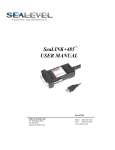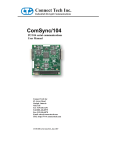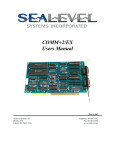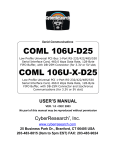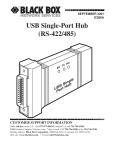Download 3055 User Manual - Sealevel Systems, Inc
Transcript
ULTRA 485™ USER MANUAL Part #3055 Sealevel Systems, Inc. PO Box 830 Liberty, SC 29657 USA Telephone: (864) 843-4343 Fax: (864) 843-3067 www.sealevel.com Contents INTRODUCTION ........................................................................ 1 OVERVIEW ......................................................................................1 WHAT’S INCLUDED.........................................................................1 FACTORY DEFAULT SETTINGS ........................................................1 CARD SETUP ............................................................................ 2 ADDRESS SELECTION ......................................................................2 IRQ SELECTION ..............................................................................3 INTERRUPT MODES .........................................................................4 RS-485 ENABLE MODES ................................................................5 CONNECTOR PIN ASSIGNMENTS......................................................7 EIA-530 ......................................................................................7 SIO-485.......................................................................................8 LINE TERMINATION ........................................................................9 INSTALLATION ....................................................................... 10 OPERATING SYSTEM INSTALLATION .............................................10 For Windows Users...................................................................10 Other Operating Systems ..........................................................10 TECHNICAL DESCRIPTION .................................................... 11 FEATURES .....................................................................................11 SPECIFICATIONS .................................................................... 12 ENVIRONMENTAL SPECIFICATIONS ...............................................12 MANUFACTURING .........................................................................12 POWER CONSUMPTION .................................................................12 MEAN TIME BETWEEN FAILURES (MTBF) ...................................12 PHYSICAL DIMENSIONS.................................................................12 APPENDIX A - TROUBLESHOOTING ...................................... 13 APPENDIX B - HOW TO GET ASSISTANCE ............................ 15 APPENDIX C - ELECTRICAL INTERFACE .............................. 16 RS-530 .........................................................................................16 RS-422 .........................................................................................16 RS-485 .........................................................................................17 APPENDIX D - ASYNCHRONOUS COMMUNICATIONS ............ 18 APPENDIX E - SILK-SCREEN ................................................. 19 APPENDIX F - COMPLIANCE NOTICES .................................. 20 FEDERAL COMMUNICATIONS COMMISSION STATEMENT...............20 EMC DIRECTIVE STATEMENT ......................................................20 WARRANTY ............................................................................ 21 Figures Figure 1 - Header E1, IRQ Selection ........................................................3 Figure 2 - Header E2, Normal IRQ Mode................................................4 Figure 3 - Header E2, Shared IRQ Mode ................................................4 Figure 4 - Header E5 RS-485 Transmit Mode.........................................5 Figure 5 - Header E3 RS-485 Receive Mode ...........................................6 Figure 6 - DIP-shunt E4 (EIA-530 Mode)................................................7 Figure 7 - DIP-shunt E4 (SIO-485 Mode) ................................................8 Figure 8 - SW2, Line Termination............................................................9 Figure 9 - Asynchronous Communications Bit Diagram......................18 © Sealevel Systems, Inc. SL9139 Revision 7/2006 Sealevel Systems, Incorporated. All rights reserved. Introduction Introduction Overview The Sealevel Systems ULTRA 485 provides the PC with an additional RS-422/485 serial port for terminals, PLC communication, laboratory instrumentation, etc. The unique feature of the ULTRA 485 is the ability to be RS-485 compatible without the need for special software or drivers. This is especially useful in Windows, Windows NT, and OS/2 environments where the lower level I/O control is abstracted from the application program. Which means that the user can effectively use the ULTRA 485 in an RS-485 application with existing (i.e. standard RS-232) software drivers. What’s Included The ULTRA 485 is shipped with the following items. If any of these items are missing or damaged, contact the supplier. • • ULTRA 485 Serial I/O Adapter Sealevel Software Factory Default Settings The ULTRA 485 factory default settings are as follows: Port # Port 1 Base Address 280 IRQ 5 Electrical Specification RS-485 ‘Auto’ To install the ULTRA 485 using factory default settings, refer to Installation on page 10. For your reference, record installed ULTRA 485 settings below: Port # Base Address Sealevel Systems ULTRA-485 IRQ Electrical Specification Page 1 Card Setup Card Setup The ULTRA 485 contains several jumper straps that must be set for proper operation. Address Selection The ULTRA 485 occupies 8 consecutive I/O locations, and looks to the PC as a standard serial port. A DIP-switch (SW1) is used to set the port address options for the ULTRA 485. Be careful when selecting the port addresses as some selections may conflict with existing ports. The following table shows the addressing options available with the standard PAL. If different address options are required, please contact Sealevel Systems Technical Support about a custom PAL option. Port1 J2 Disabled 3F8 2F8 3E8 2E8 3220 3228 4220 4228 238 300 308 280 288 290 298 SW1-1 On On On On On On On On Off Off Off Off Off Off Off Off SW1-2 On On On On Off Off Off Off On On On On Off Off Off Off SW1-3 On On Off Off On On Off Off On On Off Off On On Off Off SW1-4 On Off On Off On Off On Off On Off On Off On Off On Off Note: Each COM port in the system should have a unique address. Typically COM1: - COM4: addresses are 3F8, 2F8, 3E8 & 2E8 Hex. Sealevel Systems ULTRA-485 Page 2 Card Setup IRQ Selection Header E1 selects the interrupt request for each serial port. If COM1: is selected, the corresponding jumper must be on the IRQ4 setting. If COM2: is selected, the corresponding jumper must be on IRQ3. Note: Most communications software applications default COM3: to IRQ4 and COM4: to IRQ3. This requires the sharing of interrupts between COM1: and COM3:, and between COM2: and COM4:. While this is the default, it is not always the preferred setting. Check your software configuration instructions to determine the most appropriate IRQ selection. E1 2 3 4 5 7 10 11 12 15 Figure 1 - Header E1, IRQ Selection Any two or more ports can share a common IRQ by placing the jumpers on the same IRQ setting at header E1 and setting the appropriate selections at E2. Consult your particular software for IRQ selection. If no interrupt is desired, remove the jumper. Sealevel Systems ULTRA-485 Page 3 Card Setup Interrupt Modes Header E2 selects the interrupt mode for the ULTRA 485. ‘N’ indicates the (N)ormal, single interrupt per port mode. ‘S’ Indicates the (S)hared interrupt mode, which allows more than one port to access a single IRQ. Any two or more ports can share a common IRQ by placing the jumpers on the same IRQ setting and setting the appropriate selections at E1. Consult your particular software for IRQ selection. If no interrupt is desired, remove the jumper. ‘M’ indicates the inclusion of a 1K ohm pull-down resistor required on one port when sharing interrupts. Figure 2 - Header E2, Normal IRQ Mode Set the jumper to ‘S’ if you are using more than one ULTRA 485 in a bus or to completely remove the pull-down resistor for hardware compatibility. Setting the adapter in this configuration when it is not accompanied by a pull-down resistor will prevent the ports from triggering an interrupt. Set the jumpers to ‘S’ for shared interrupt mode on all blocks sharing an IRQ except one. Set that port block for ‘M’. This provides the pull-down resistor circuit that makes sharing IRQs possible. If you are using more than one ULTRA 485 or a compatible adapter in a bus you should only have one port set to ‘M’. The following example shows two ULTRA 485 adapters sharing a single IRQ. Figure 3 - Header E2, Shared IRQ Mode Sealevel Systems ULTRA-485 Page 4 Card Setup RS-485 Enable Modes RS-485 is ideal for multi-drop or network environments. RS-485 requires a tri-state driver (not dual-state) that will allow the electrical presence of the driver to be removed from the line. The driver is in a tri-state or high impedance condition when this occurs. Only one driver may be active at a time and the other driver(s) must be tri-stated. The output modem control signal Request To Send (RTS) is typically used to control the state of the driver. Some communication software packages refer to RS-485 as RTS enable or RTS block mode transfer. One of the unique features of the ULTRA 485 is the ability to be RS-485 compatible without the need for special software or drivers. This ability is especially useful in Windows, Windows NT, and OS/2 environments where the lower level I/O control is abstracted from the application program. This ability means that the user can effectively use the ULTRA 485 in a RS-485 application with existing (i.e. standard RS-232) software drivers. Header E5 is used to control the RS-485 mode functions for the transmitter circuit. The selections are ‘RTS’ enable, ‘Auto’ enable, or ‘422’ which means always enabled. The ‘Auto’ enable feature automatically enables/disables the RS-485 transmitter circuit. The ‘RTS’ mode uses the ‘RTS’ modem control signal to enable the RS-485 transmitter circuit and provides backward compatibility with existing software products. The ‘422’ mode allows the port to be used in a point to point RS-422 application where the tri-stating of the transmitter circuit is not required. E5 AUTO RTS 422 TX AUTO RTS 422 Driver automatically enabled/disabled Driver enabled by UART RTS signal Driver always enabled Note: The jumper in the above example is in the ‘422’ position. This is the only setting in which the modem control outputs (RTS, DTR) are valid. Figure 4 - Header E5 RS-485 Transmit Mode Sealevel Systems ULTRA-485 Page 5 Card Setup Header E3 is used to control the RS-485 enable/disable functions for the receiver circuit. The RS-485 ‘Echo’ is the result of connecting the receiver inputs to the transmitter outputs. Every time a character is transmitted, it is also received. This can be beneficial if the software can handle echoing (i.e. using received characters to throttle the transmitter) or it can confuse the system if the software does not. The selection at E3 should follow the selection made at E5 if ‘No Echo’ is desired. If Echo suppression is not desired then leave the jumper in the ‘422’ position. Also note, the modem control inputs (DSR, DCD, CTS) are only valid when Header E3 is in the 422 mode. These header blocks are described in the illustration and table that follow. E3 AUTO RTS 422 RX AUTO RTS 422 Receiver automatically enabled/disabled Receiver enabled by UART RTS signal Receiver always enabled Figure 5 - Header E3 RS-485 Receive Mode Sealevel Systems ULTRA-485 Page 6 Card Setup Connector Pin Assignments EIA-530 DIP-shunt E4 selects the pin out for the DB-25 connector P3. With the 5 position shunt in the EIA-530 mode, the ULTRA 485 complies with the EIA530 pin out with the following signals supported: E4 SIO-485 EIA-530 Figure 6 - DIP-shunt E4 (EIA-530 Mode) Signal GND RDB RDA CTSB CTSA DSRB DSRA DCDB DCDA TDB TDA RTSB RTSA DTRB DTRA RX+ RXCTS+ CTSDSR+ DSRDCD+ DCDTX+ TXRTS+ RTSDTR+ DTR- Name Ground Receive Positive Receive Negative Clear To Send Positive Clear To Send Negative Data Set Ready Positive Data Set Ready Negative Data Carrier Detect Positive Data Carrier Detect Negative Transmit Positive Transmit Negative Request To Send Positive Request To Send Negative Data Terminal. Ready Positive Data Terminal Ready Negative Sealevel Systems ULTRA-485 Pin # 7 16 3 13 5 22 6 10 8 14 2 19 4 23 20 Mode Input Input Input Input Input Input Input Input Output Output Output Output Output Output Page 7 Card Setup SIO-485 With the 5-position shunt in the SIO-485 mode, the ULTRA 485 is compatible with the Sealevel Systems SIO-485 (part# 3054) with the following signals supported: E4 EIA-530 SIO-485 Figure 7 - DIP-shunt E4 (SIO-485 Mode) Signal GND TDB TDA RDB RDA / TX+ TXRX+ RX- Name Ground Transmit Positive Transmit Negative Receive Positive Receive Negative Sealevel Systems ULTRA-485 Pin # 7 24 25 12 13 Mode Output Output Input Input Page 8 Card Setup Line Termination Typically, each end of the RS-485 bus must have line terminating resistors (RS422 terminates at the receive end only). A 100-ohm resistor is across each RS530/422/485 input in addition to a 1K ohm pull-up/pull-down combination that biases the receiver inputs. DIP-switch SW2 provides the ability to customize this interface to system requirements. Each switch position corresponds to a specific portion of the interface. If multiple ULTRA 485 adapters are configured in a RS-485 network, only the boards on each end should have switches T, P & P ON. Refer to the following table for each position’s operation: Name T P P L L Function Adds or removes the 100 ohm termination. Adds or removes the 1K ohm pull-down resistor in the RS-422/RS-485 receiver circuit (Receive data only). Adds or removes the 1K ohm pull-up resistor in the RS-422/RS485 receiver circuit (Receive data only). Connects the TX+ to RX+ for RS-485 two-wire operation. Connects the TX- to RX- for RS-485 two-wire operation. Figure 8 - SW2, Line Termination ON O FF 1 2 3 4 5 T P P L L Sealevel Systems ULTRA-485 Page 9 Installation Installation Operating System Installation For Windows Users Start by choosing Install Software at the beginning of the CD. Choose Asynchronous COM: Port Software, SeaCOM. Other Operating Systems Refer to the appropriate section of the Serial Utilities Software.System Installation The ULTRA 485 can be installed in any of the PC expansion slots. The ULTRA 485 contains several jumper straps for each port that must be set for proper operation. 1. 2. 3. 4. 5. 6. 7. Turn off PC power. Disconnect the power cord. Remove the PC case cover. Locate an available slot and remove the blank metal slot cover. Gently insert the ULTRA 485 into the slot. Make sure that the adapter is seated properly. Replace the screw. Replace the cover. Connect the power cord. Installation is complete. Sealevel Systems ULTRA-485 Page 10 Technical Description Technical Description The ULTRA 485 utilizes the 16550 UART. This chip features programmable baud rates, data format, interrupt control and a 16-byte input and output FIFO. A full array of advanced UARTS is also available. The unique feature of the ULTRA 485 is the ability to be RS-485 compatible without the need for special software or drivers. This is especially useful in Windows, Windows NT, and OS/2 environments where the lower level I/O control is abstracted from the application program. Which means that the user can effectively use the ULTRA 485 in a RS-485 application with existing (i.e. standard RS-232) software drivers. Features • • • • • • Automatic RS-485 driver enable/disable allows card to appear to be standard COM: port requiring no additional drivers ‘PAL’ option allows for unique OEM address selection ‘Shareable’ IRQs allow more than one port to share a single IRQ provided a polling type driver is used IRQs 2/9-7, 10, 11, 12, 14, 15 supported 16550 buffered UART standard 16 Bit address decode allows for easier integration Sealevel Systems ULTRA-485 Page 11 Specifications Specifications Environmental Specifications Specification Temperature Range Humidity Range Operating 0º to 50º C (32º to 122º F) 10 to 90% R.H. Non-Condensing Storage -20º to 70º C (-4º to 158º F) 10 to 90% R.H. Non-Condensing Manufacturing • All Sealevel Systems Printed Circuit boards are built to U.L. 94V0 rating and are 100% electrically tested. These printed circuit boards are solder mask over bare copper or solder mask over tin nickel. Power Consumption +5 VDC 160 mA Supply line Rating Mean Time Between Failures (MTBF) Greater than 150,000 hours. (Calculated) Physical Dimensions Board length Board Height including Goldfingers Board Height excluding Goldfingers Board Weight Sealevel Systems ULTRA-485 5.0 inches 4.2 inches 3.9 inches 0.22 Lbs. (12.70 cm) (10.66 cm) (9.91 cm) Page 12 Appendix A - Troubleshooting Appendix A - Troubleshooting Serial Utility test software is supplied with the Sealevel Systems adapter and will be used in the troubleshooting procedures. By using this software and following these simple steps, most common problems can be eliminated without the need to call Technical Support. 1. Identify all I/O adapters currently installed in your system. This includes your on-board serial ports, controller cards, sound cards etc. The I/O addresses used by these adapters, as well as the IRQ (if any) should be identified. 2. Configure your Sealevel Systems adapter so that there is no conflict with currently installed adapters. No two adapters can occupy the same I/O address. 3. Make sure the Sealevel Systems adapter is using a unique IRQ. The IRQ is typically selected via an on-board header block. Refer to the section on Card Setup for help in choosing an I/O address and IRQ. 4. Make sure the Sealevel Systems adapter is securely installed in a motherboard slot. 5. When running DOS, Windows 3.x or other operating systems refer to the Serial Utilities software for that operating system and the User Manual to verify that the Sealevel Systems adapter is configured correctly. The supplied software contains a diagnostic program 'SSD' that runs under DOS and will verify if an adapter is configured properly. This diagnostic program is written with the user in mind and is easy to use. Refer to the DIAG.txt file in the dos\diag directory for detailed instructions on using 'SSD'. 6. For Windows 95/98 and Windows NT, the diagnostic tool 'WinSSD' is installed in the Sealevel folder on the Start Menu during the setup process. First find the ports using the Device Manager, then use 'WinSSD' to verify that the ports are functional. 7. Always use the Sealevel Systems diagnostic software when troubleshooting a problem. This will help eliminate any software issues and identify any hardware conflicts. Sealevel Systems ULTRA-485 Page 13 Appendix A - Troubleshooting 8. The following are known I/O conflicts: • • • • • • The 278 and 378 settings may conflict with your printer I/O adapter. 3B0 cannot be used if a Monochrome adapter is installed. 3F8-3FF is typically reserved for COM1: 2F8-2FF is typically reserved for COM2: 3E8-3EF is typically reserved for COM3: 2E8-2EF is typically reserved for COM4: Sealevel Systems ULTRA-485 Page 14 Error! Reference source not found. Appendix B - How To Get Assistance Please refer to Troubleshooting Guide prior to calling Technical Support. 1. Begin by reading through the Trouble Shooting Guide in Appendix A. If assistance is still needed please see below. 2. When calling for technical assistance, please have your user manual and current adapter settings. If possible, please have the adapter installed in a computer ready to run diagnostics. 3. Sealevel Systems provides an FAQ section on its web site. Please refer to this to answer many common questions. This section can be found at http://www.sealevel.com/faq.htm . 4. Sealevel Systems maintains a Home page on the Internet. Our home page address is www.sealevel.com. The latest software updates, and newest manuals are available via our FTP site that can be accessed from our home page. 5. Technical support is available Monday to Friday from 8:00 a.m. to 5:00 p.m. eastern time. Technical support can be reached at (864) 843-4343. RETURN AUTHORIZATION MUST BE OBTAINED FROM SEALEVEL SYSTEMS BEFORE RETURNED MERCHANDISE WILL BE ACCEPTED. AUTHORIZATION CAN BE OBTAINED BY CALLING SEALEVEL SYSTEMS AND REQUESTING A RETURN MERCHANDISE AUTHORIZATION (RMA) NUMBER. Sealevel Systems ULTRA-485 Page 15 Appendix C - Electrical Interface Appendix C - Electrical Interface RS-530 RS-530 (a.k.a. EIA-530) compatibility means that RS-422 signal levels are met, and the pin-out for the DB-25 connector is specified. The EIA (Electronic Industry Association) created the RS-530 specification to detail the pin-out, and define a full set of modem control signals that can be used for regulating flow control and line status. The RS-530 specification defines two types of interface circuits, Data Terminal Equipment (DTE) and Data Circuit-Terminating Equipment (DCE). The Sealevel Systems adapter is a DTE interface. RS-422 The RS-422 specification defines the electrical characteristics of balanced voltage digital interface circuits. RS-422 is a differential interface that defines voltage levels and driver/receiver electrical specifications. On a differential interface, logic levels are defined by the difference in voltage between a pair of outputs or inputs. In contrast, a single ended interface, for example RS-232, defines the logic levels as the difference in voltage between a single signal and a common ground connection. Differential interfaces are typically more immune to noise or voltage spikes that may occur on the communication lines. Differential interfaces also have greater drive capabilities that allow for longer cable lengths. RS-422 is rated up to 10 Megabits per second and can have cabling 4000 feet long. RS-422 also defines driver and receiver electrical characteristics that will allow 1 driver and up to 32 receivers on the line at once. RS-422 signal levels range from 0 to +5 volts. RS-422 does not define a physical connector. Sealevel Systems ULTRA-485 Page 16 Appendix C - Electrical Interface RS-485 RS-485 is backwardly compatible with RS-422; however, it is optimized for partyline or multi-drop applications. The output of the RS-422/485 driver is capable of being Active (enabled) or Tri-State (disabled). This capability allows multiple ports to be connected in a multi-drop bus and selectively polled. RS-485 allows cable lengths up to 4000 feet and data rates up to 10 Megabits per second. The signal levels for RS-485 are the same as those defined by RS-422. RS-485 has electrical characteristics that allow for 32 drivers and 32 receivers to be connected to one line. This interface is ideal for multi-drop or network environments. RS-485 tri-state driver (not dual-state) will allow the electrical presence of the driver to be removed from the line. Only one driver may be active at a time and the other driver(s) must be tri-stated. RS-485 can be cabled in two ways, two wire and four wire mode. Two wire mode does not allow for full duplex communication and requires that data be transferred in only one direction at a time. For half-duplex operation, the two transmit pins should be connected to the two receive pins (Tx+ to Rx+ and Tx- to Rx-). Four wire mode allows full duplex data transfers. RS-485 does not define a connector pin-out or a set of modem control signals. RS-485 does not define a physical connector. Sealevel Systems ULTRA-485 Page 17 Appendix D - Asynchronous Communications Appendix D - Asynchronous Communications Serial data communications implies that individual bits of a character are transmitted consecutively to a receiver that assembles the bits back into a character. Data rate, error checking, handshaking, and character framing (start/stop bits) are pre-defined and must correspond at both the transmitting and receiving ends. Asynchronous communications is the standard means of serial data communication for PC compatibles and PS/2 computers. The original PC was equipped with a communication or COM: port that was designed around an 8250 Universal Asynchronous Receiver Transmitter (UART). This device allows asynchronous serial data to be transferred through a simple and straightforward programming interface. Character boundaries for asynchronous communications are defined by a starting bit followed by a pre-defined number of data bits (5, 6, 7, or 8). The end of the character is defined by the transmission of a pre-defined number of stop bits (usually 1, 1.5 or 2). An extra bit used for error detection is often appended before the stop bits. Idle state of line 5 to 8 Data Bits Odd, Even or Unused Remain Idle or next start bit 1 P BIT STOP 0 1 1.5 2 Figure 9 - Asynchronous Communications Bit Diagram This special bit is called the parity bit. Parity is a simple method of determining if a data bit has been lost or corrupted during transmission. There are several methods for implementing a parity check to guard against data corruption. Common methods are called (E)ven Parity or (O)dd Parity. Sometimes parity is not used to detect errors on the data stream. This is refereed to as (N)o parity. Because each bit in asynchronous communications is sent consecutively, it is easy to generalize asynchronous communications by stating that each character is wrapped (framed) by pre-defined bits to mark the beginning and end of the serial transmission of the character. The data rate and communication parameters for asynchronous communications have to be the same at both the transmitting and receiving ends. The communication parameters are baud rate, parity, number of data bits per character, and stop bits (i.e. 9600,N,8,1). Sealevel Systems ULTRA-485 Page 18 Appendix E - Silk-Screen Appendix E - Silk-Screen Sealevel Systems ULTRA-485 Page 19 Appendix F - Compliance Notices Appendix F - Compliance Notices Federal Communications Commission Statement FCC - This equipment has been tested and found to comply with the limits for Class A digital device, pursuant to Part 15 of the FCC Rules. These limits are designed to provide reasonable protection against harmful interference when the equipment is operated in a commercial environment. This equipment generates, uses, and can radiate radio frequency energy and, if not installed and used in accordance with the instruction manual, may cause harmful interference to radio communications. Operation of this equipment in a residential area is likely to cause harmful interference in such case the user will be required to correct the interference at his own expense. EMC Directive Statement Products bearing the CE Label fulfill the requirements of the EMC directive (89/336/EEC) and of the low-voltage directive (73/23/EEC) issued by the European Commission. To obey these directives, the following European standards must be met: • EN55022 Class A - “Limits and methods of measurement of radio interference characteristics of information technology equipment” EN55024-‘Information technology equipment Immunity Limits and methods of measurement. • characteristics EN60950 (IEC950) - “Safety of information technology equipment, including electrical business equipment” Warning This is a Class A Product. In a domestic environment this product may cause radio interference in which case the user may be required to take adequate measures. Always use cabling provided with this product if possible. If no cable is provided or if an alternate cable is required, use high quality shielded cabling to maintain compliance with FCC/EMC directives. Sealevel Systems ULTRA-485 Page 20 Warranty Warranty Sealevel Systems, Inc. provides a limited lifetime warranty. Should this product fail to be in good working order at any time during this period, Sealevel Systems will, at it’s option, replace or repair it at no additional charge except as set forth in the following terms. This warranty does not apply to products damaged by misuse, modifications, accident or disaster. Sealevel Systems assumes no liability for any damages, lost profits, lost savings or any other incidental or consequential damage resulting from the use, misuse of, or inability to use this product. Sealevel Systems will not be liable for any claim made by any other related party. RETURN AUTHORIZATION MUST BE OBTAINED FROM SEALEVEL SYSTEMS BEFORE RETURNED MERCHANDISE WILL BE ACCEPTED. AUTHORIZATION CAN BE OBTAINED BY CALLING SEALEVEL SYSTEMS AND REQUESTING A RETURN MERCHANDISE AUTHORIZATION (RMA) NUMBER. Sealevel Systems, Incorporated 2779 Greenville Highway P.O. Box 830 Liberty, SC 29657 USA (864) 843-4343 FAX:(864) 843-3067 www.sealevel.com email: [email protected] Technical Support is available from 8 a.m. to 5 p.m. Eastern time. Monday - Friday Trademarks Sealevel Systems, Incorporated acknowledges that all trademarks referenced in this manual are the service mark, trademark, or registered trademark of the respective company. ULTRA 485 is a trademark of Sealevel Systems, Incorporated. Sealevel Systems ULTRA-485 Page 21
























